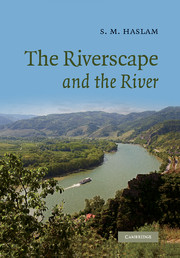Book contents
- Frontmatter
- Contents
- List of tables
- Preface
- Acknowledgements
- 1 Introduction
- 2 The natural river and its destruction
- 3 The natural riverscape and its modification
- 4 Resources I. Water resources and their loss
- 5 Development and variation of rivers
- 6 Development and variation of riverscapes
- 7 Building blocks of river vegetation
- 8 Building blocks of flood plain vegetation
- 9 Resources II. Plants and animals, cleaning and minerals
- 10 Building blocks of the riverscape
- 11 Patterns, boundaries and fragmentation
- 12 Resources III. Settlements and constructions
- 13 The harsh riverscape
- 14 The tempered or smiling riverscape
- 15 Envoi
- Bibliography
- Index to plant and animal vernacular and taxonomic names
- General subject index
4 - Resources I. Water resources and their loss
Published online by Cambridge University Press: 10 August 2009
- Frontmatter
- Contents
- List of tables
- Preface
- Acknowledgements
- 1 Introduction
- 2 The natural river and its destruction
- 3 The natural riverscape and its modification
- 4 Resources I. Water resources and their loss
- 5 Development and variation of rivers
- 6 Development and variation of riverscapes
- 7 Building blocks of river vegetation
- 8 Building blocks of flood plain vegetation
- 9 Resources II. Plants and animals, cleaning and minerals
- 10 Building blocks of the riverscape
- 11 Patterns, boundaries and fragmentation
- 12 Resources III. Settlements and constructions
- 13 The harsh riverscape
- 14 The tempered or smiling riverscape
- 15 Envoi
- Bibliography
- Index to plant and animal vernacular and taxonomic names
- General subject index
Summary
The well-being of the water environment is fundamental to sustainable development.
(J. Gardiner, 1991)The sustainable development of a country requires wetlands in being.
(W. Mitsch, 1994)Introduction
Water is the most important component of life on earth. Living organisms are mostly water (e.g. a baby over 70%, lettuce over 90%). All must be able to maintain this content, against the constant pull of evapotranspiration, evaporation and secretion.
The water is replenished, ultimately, from precipitation. Depending on the species, it comes from rain (snow, ice) or dew, and surface, soil or ground water. Where there is life, there is water.
Water therefore passes from rain to river through the riverscape. That which does not, evaporates direct from the rain (varying with climate and surface cover). That which does, may be absorbed above the soil, by plants mostly, or pass above the soil, through it, or through lower levels in the ground (subsoil, aquifer). This last may be little (impermeable rock close to surface) or much (wet peat, alluvium, aquifer).
Sheet flow is usually only in very heavy storms (though these may be frequent, e.g. Chapter 3, R. Waccasassee, or extremely rare). The water may flow to the river or, and more so on steeper land, it may gather into watercourses first. Surface flow, just on or within the soil, is more usual. On slopes, rainsplash and overland flow is discontinuous in space and time, but is a single interacting phenomenon (Petts & Foster, 1985).
- Type
- Chapter
- Information
- The Riverscape and the River , pp. 86 - 106Publisher: Cambridge University PressPrint publication year: 2008



